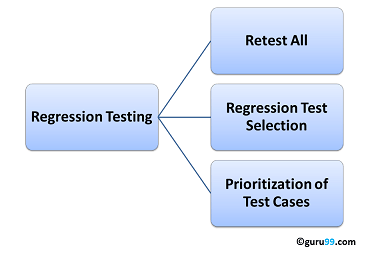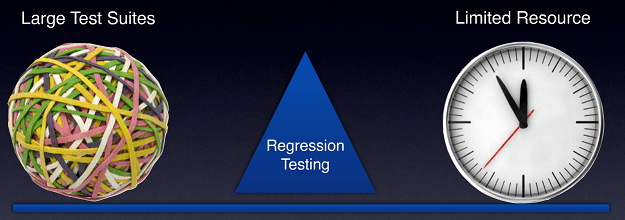REGRESSION TESTING is defined as a type of software testing to confirm that a recent program or code change has not adversely affected existing features.
Regression Testing is nothing but a full or partial selection of already executed test cases which are re-executed to ensure existing functionalities work fine.
This testing is done to make sure that new code changes should not have side effects on the existing functionalities. It ensures that the old code still works once the latest code changes are done.
In this tutorial, we will learn
- Need of Regression Testing
- How to do Regression Testing
- Selecting test cases for regression testing
- Regression Testing Tools
- Regression Testing and Configuration Management
- Difference between Re-Testing and Regression Testing
- Challenges in Regression Testing
- Practical Application of Regression Testing Example with a Video
Need of Regression Testing
Regression Testing is required when there is a
- Change in requirements and code is modified according to the requirement
- New feature is added to the software
- Defect fixing
- Performance issue fix
How to do Regression Testing
Software maintenance is an activity which includes enhancements, error corrections, optimization and deletion of existing features. These modifications may cause the system to work incorrectly. Therefore, Regression Testing becomes necessary. Regression Testing can be carried out using the following techniques:
Retest All
- This is one of the methods for Regression Testing in which all the tests in the existing test bucket or suite should be re-executed. This is very expensive as it requires huge time and resources.
Regression Test Selection
- Instead of re-executing the entire test suite, it is better to select part of the test suite to be run
- Test cases selected can be categorized as 1) Reusable Test Cases 2) Obsolete Test Cases.
- Re-usable Test cases can be used in succeeding regression cycles.
- Obsolete Test Cases can't be used in succeeding cycles.
Prioritization of Test Cases
- Prioritize the test cases depending on business impact, critical & frequently used functionalities. Selection of test cases based on priority will greatly reduce the regression test suite.
Selecting test cases for regression testing
It was found from industry data that a good number of the defects reported by customers were due to last minute bug fixes creating side effects and hence selecting the Test Case for regression testing is an art and not that easy. Effective Regression Tests can be done by selecting the following test cases -
- Test cases which have frequent defects
- Functionalities which are more visible to the users
- Test cases which verify core features of the product
- Test cases of Functionalities which has undergone more and recent changes
- All Integration Test Cases
- All Complex Test Cases
- Boundary value test cases
- A sample of Successful test cases
- A sample of Failure test cases
Regression Testing Tools
If your software undergoes frequent changes, regression testing costs will escalate.
In such cases, Manual execution of test cases increases test execution time as well as costs.
Automation of regression test cases is the smart choice in such cases.
The extent of automation depends on the number of test cases that remain re-usable for successive regression cycles.
Following are the most important tools used for both functional and regression testing in software engineering.
Ranorex Studio: all-in-one regression test automation for desktop, web, and mobile apps with built-in Selenium WebDriver. Includes a full IDE plus tools for codeless automation.
Selenium: This is an open source tool used for automating web applications. Selenium can be used for browser-based regression testing.
Quick Test Professional (QTP): HP Quick Test Professional is automated software designed to automate functional and regression test cases. It uses VBScript language for automation. It is a Data-driven, Keyword based tool.
Rational Functional Tester (RFT): IBM's rational functional tester is a Java tool used to automate the test cases of software applications. This is primarily used for automating regression test cases and it also integrates with Rational Test Manager.
Regression Testing and Configuration Management
Configuration Management during Regression Testing becomes imperative in Agile Environments where a code is being continuously modified. To ensure effective regression tests, observe the following :
- Code being regression tested should be under a configuration management tool
- No changes must be allowed to code, during the regression test phase. Regression test code must be kept immune to developer changes.
- The database used for regression testing must be isolated. No database changes must be allowed
Difference between Re-Testing and Regression Testing:
Retesting means testing the functionality or bug again to ensure the code is fixed. If it is not fixed, Defect needs to be re-opened. If fixed, Defect is closed.
Regression testing means testing your software application when it undergoes a code change to ensure that the new code has not affected other parts of the software.
Challenges in Regression Testing:
Following are the major testing problems for doing regression testing:
- With successive regression runs, test suites become fairly large. Due to time and budget constraints, the entire regression test suite cannot be executed
- Minimizing the test suite while achieving maximum Test coverage remains a challenge
- Determination of frequency of Regression Tests, i.e., after every modification or every build update or after a bunch of bug fixes, is a challenge.
Practical Application of Regression Testing Example with a Video
Click here if the video is not accessible
Conclusion:
An effective regression strategy, save organizations both time and money. As per one of the case study in banking domain, regression saves up to 60% time in bug fixes(which would have been caught by regression tests) and 40% in money


No comments:
Post a Comment